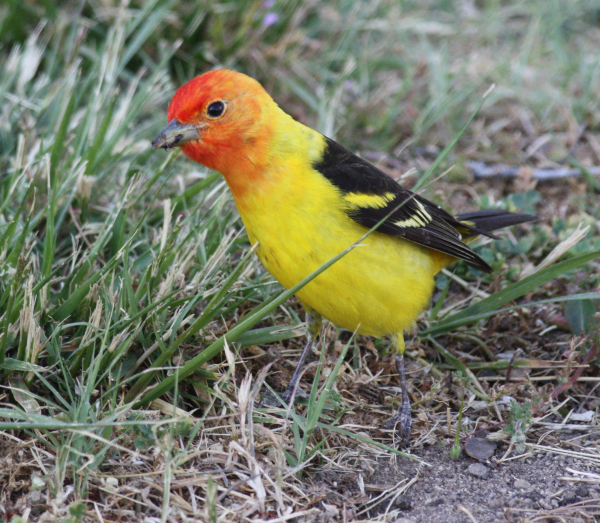
Migrating Western Tanagers are among the many birds impacted along the West Coast (photo by Paul Konrad).
|
An estimated 600 million birds die from colliding with buildings every year in the United States. Scientists at the Cornell Lab of Ornithology recently published new research that shows city lights at night as a contributing factor to bird collisions with windows and buildings. They ranked metropolitan areas where birds are at greatest risk of being attracted to and disoriented by lights and crashing into buildings, due to a combination of light pollution and geography. The most dangerous American cities for birds during fall and spring migrations are Chicago, Houston, and Dallas.
The research was published in the journal Frontiers in Ecology and the Environment and it combines satellite data that shows light pollution levels with weather radar that measures bird migration density. Because many birds take different migration routes during spring and fall, rankings of the most-dangerous cities change slightly with the season.
During spring migration, billions of birds migrate through the central United States between the Rockies and Appalachians, so it’s not a big surprise that cities in the middle of the country are among the most dangerous during fall and spring migrations. Greater spring migration along the West Coast also puts Los Angeles on the spring most dangerous cities list. Fall bird migration tends to be more intense along the heavily light-polluted Atlantic seaboard, which is why four eastern cities make the “top 10” list during autumn.
The 10 Most Dangerous American Cities for Birds during FALL Migration: 1) Chicago, 2) Houston, 3) Dallas, 4) Atlanta, 5) New York, 6) St. Louis, 7) Minneapolis, 8) Kansas City, 9) Washington, D.C., 10) Philadelphia
The 10 Most Dangerous American Cities for Birds during SPRING Migration: 1) Chicago 2) Houston 3) Dallas 4) Los Angeles 5) St. Louis 6) Minneapolis 7) Kansas City 8) New York 9) Atlanta 10) San Antonio.
“Chicago, Houston, and Dallas are uniquely positioned in the heart of North America’s most trafficked aerial corridors. This, in combination with being some of the largest cities in the United States, make them a serious threat to the passage of migrants, regardless of season,” noted the study’s lead author Kyle Horton, a Rose Post-doctoral Fellow at the Cornell Lab.
Although bird migration during spring and fall continues for months, the most migratory activity occurs during the span of just a few days. For example, a top-ranked light-polluting city can expect half the birds migrating through during seven nights spaced out during the season; these nights are unique for each city and depend upon wind conditions, temperature, and timing.
“Now that we know where and when the largest numbers of migratory birds pass heavily lighted areas we can use this to help spur extra conservation efforts in these cities,” added study co-author Cecilia Nilsson, also a Rose Post-doctoral Fellow at the Cornell Lab. “For example, Houston Audubon uses migration forecasts from the Lab’s BirdCast program to run ‘lights out’ warnings on nights when large migratory movements are expected over the city.”
Horton also noted that, considering that an estimated quarter-million birds die from collisions with houses and residences every year, even homeowners can play an important role in the most dangerous metro areas for migrating birds – actually anywhere.
“If you don’t need lights on, turn them off,” encouraged Horton. “It’s a large-scale issue, but acting even at the very local level to reduce lighting can make a difference. While we’re hopeful that major reductions in light pollution at the city level are on the horizon, we’re excited that even small-scale actions can make a big difference.”
And if you need lights turned on at night, simply close the shades or curtains, and that can make a big difference in residential and commercial areas.
To reference the scientific publication described in this article, see:
K.G. Horton, C. Nilsson, B.M. Van Doren, F.A. La Sorte, A.M. Dokter, A. Farnsworth. Bright lights in the big cities: Migratory birds’ exposure to artificial light. Frontiers in Ecology and the Environment. 2019.
The original article that provided this information, can be referred to at https://mailchi.mp/cornell/release-study-lists-top-cities-where-lights-endanger-migratory-birds-1314385